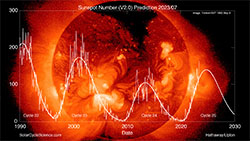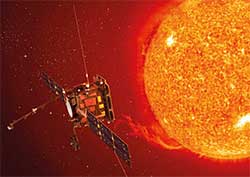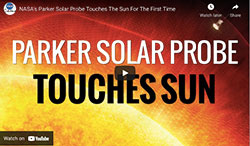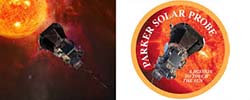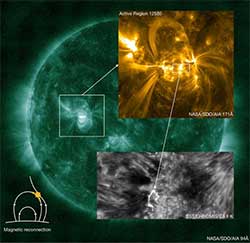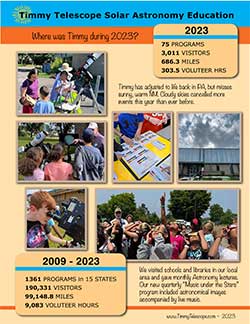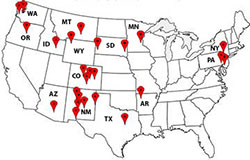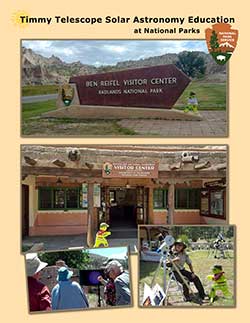
Timmy Telescope Solar Astronomy Education is a SE Pennsylvania informal education non-profit organization dedicated to providing current Earth and Space Science information to the public. Since 2009 we have provided over 1300 free programs to approximately 200,000 children and adults representing the entire spectrum of American society.
During our lessons, largely Hispanic, Native American and African American populations of young people have been able to directly observe and learn about the Sun, the closest star to the Earth. We also focus on the science/career of spectroscopy or how scientists use light. Less than 1% of the world’s population ever gets this opportunity.
These programs have attempted to help fill gaps in classroom, museum or library based programming due to a lack of resources (such as trained experts, and expensive, state-of-the–art equipment). In the future, we would like to provide 1 to 3 hour presentations to organizations needing to supplement their educational programs.
See our video: Roger Kennedy explains our Outreach Presentations
Email to request a presentation
Nuclear in Space with Timmy Telescope
What's new on the Sun?
For the lastest information about the Sun and how it affects the Earth check SolarHam.com --solar news and data from various sources in one spot for easy navigation.
- SpaceWeather.com
- Association of Lunar and Planetary Observers: Solar Section
- Inouye Solar Telescope
- NOAA Space Weather Prediction Center (SWPC) |
Solar Cycle Progression [interactive] - Solar Dynamics Observatory (SDO)
- Solar and Heliospheric Observatory (SOHO)
- Solar Terrestrial Relations Observatory (STEREO)
- Advanced Composition Explorer (ACE)
- Large Angle and Spectrometric Coronagraph Experiment (LASCO)
- Ionospheric Connection Explorer (ICON)
What will ICON do? [video] - Magnetospheric Multiscale Mission [MMS]
- additional solar links
Current Research
Observe the Sun| tutorial. New Website from UK Solar Physics showing Past and Present Solar Activity
07/05/2023:Sunspot count hits a 21-year high.
05/07/23: Listen to the Sounds of Space (Heliophysics Audified: Resonances in Plasma (HARP)
05/05/2023: `Space waves' offer new clues to space weather, Embry-Riddle researchers report. When solar wind hits the magnetosphere, it creates breaking waves known to scientists as Kelvin-Helmholtz waves. This wave activity is seasonal, researchers found; it increases around the spring and fall seasons (equinoxes) and decreases around summer and winter (solstices). New knowledge on "space waves" could potentially lead to improved space-weather forecasts and safer satellite navigation in radiation belts, as stated by researchers at Embry-Riddle Aeronautical University [Space Weather].
04/12/2023: Study of Long-Term Solar Datasets: Exploring Spatio-Temporal Patterns of Solar Variability on Different Time Scales and Implications in Space Weather". The Sun is a magnetically active star with spatio-temporal variability, which can impact our terrestrial system. Various MHD models can simulate certain aspects of the evolution of the solar magnetic field on different time scales. Recently data-driven models as well as coupling data with models by means of data assimilation and information theoretic approach are being explored. [Solar Cycles]
01/23/2023: Astronomers captured a radio signal from the most distant galaxy. Detecting radio signals emitted by nearby galaxies could help astronomers answer how stars form in distant galaxies. [Spectroscopy]
12/09/2022: Solar Orbiter solves magnetic switchback mystery. With data from its closest pass of the Sun yet, the ESA/NASA Solar Orbiter spacecraft has found compelling clues as to the origin of magnetic switchbacks, and points towards how their physical formation mechanism might help accelerate the solar wind. [Magnetic Fields and Waves]
10/2022: Uniting the Sun’s Hale magnetic cycle and “extended solar cycle” paradigms. Through meticulous daily observation of the Sun’s large-scale magnetic field the Wilcox Solar Observatory (WSO) has catalogued two magnetic (Hale) cycles of solar activity. Those two (~22-year long) Hale cycles have yielded four (~11-year long) sunspot cycles (numbers 21 through 24). Recent research has highlighted the persistence of the “Extended Solar Cycle” (ESC) and its connection to the fundamental Hale Cycle. [Solar Cycles]/p>
04/14/2022: Webb vs Hubble Telescope. [Spectroscopy]
04/12/2022: James Webb Space Telescope's next-gen spectrograph can observe 100 galaxies in one go. [Spectroscopy]
04/03/2022: Reading the Rainbow: Planets. Discover how astronomers read spectra to learn the story of distant planets. Also watch videos on using spectra to determine Temperature, Speed and Distance. [Spectroscopy]
04/02/2022: The Difference Between Flares and CMEs. [Solar Flares...]
04/01/2022: The Sun’s coronal loops may be an optical illusion . Some of the most spectacular features on the Sun are its coronal loops — incandescent structures of hot plasma that arc for thousands of miles above magnetically active regions of the Sun, forming what appear to be curving strands. A team of solar physicists say these iconic structures may not actually be loops at all. Instead, the loops may be an illusion rooted in a more complex structure — a magnetic sheet or curtain that is being pulled and wrinkled. [Magnetic Fields and Waves]
03/28/2022: Scientists Detect Bizarre High-Frequency Waves Coming From The Sun's Surface. Researchers have discovered a new set of waves in the Sun that, unexpectedly, appear to travel much faster than predicted by theory. The high-frequency retrograde (HFR) waves -- which move in the opposite direction of the Sun's rotation -- appear as a pattern of vortices (swirling motions) on the surface of the Sun and move at three times the speed established by current theory.
03/25/2022: Scientists solve solar secret. The further we move away from a heat source, the cooler the air gets. Bizarrely, the same can’t be said for the Sun, but University of Otago scientists may have just explained a key part of why. [Solar Wind]
Events in 2024: 30
Visitors YTD: 4759
Events since 2009: 1390
Visitors since 2009: 195,090
2024 Solar Eclipse
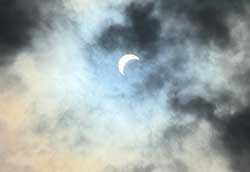
Timmy caught glimpses of the Eclipse through the clouds at Hibernia County Park, Coatsville, PA.
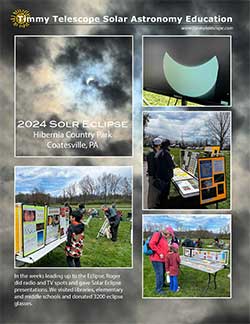
larger image [PDF]
Where has Timmy been?
View pdfs of our events
Look for Timmy at our next event
Timmy enjoys setting up and sharing the Sun with visitors at our National Parks. See which ones he's visited.
Click on the pdf links on Where was Timmy? to view more photos
Learn about the amazing women at Harvard University Observatory known as the "Harvard Computers"
